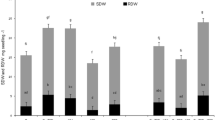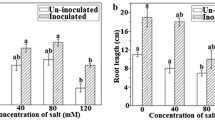Abstract
Salinity is a serious threat to agriculture in arid and semi-arid regions including Egypt. There is currently a need to select highly salt-tolerant plants to improve recycling of agricultural drainage waters. Due to the importance of Casuarina in soil reclamation and rehabilitation, our study was carried out to evaluate the survival and growth of inoculated Casuarina glauca in hydroponic N-free medium supplemented with different NaCl concentrations (50, 100, 200, 300, 400 and 500 mM). Salt tolerant Frankia strains CcI156 and CgIM4, isolated from root nodules of Casuarina trees grown in loamy sand soils in Egypt, were used for seedling inoculation. Our results showed that inoculated Casuarina seedlings were able to withstand up to 200 mM NaCl. At higher NaCl concentrations (300 to 500 mM), the seedling died gradually three days after exposure to salt stress. However, at lower NaCl (50 mM) concentration, inoculated C. glauca seedlings showed a higher growth rate and higher percentages of nodulation. Nitrogenase activity and the total nitrogen content of nodulated seedlings were also influenced by elevated NaCl concentrations and recorded a reduction at high concentration (200 mM). Salt stress had a strong effect on biosynthesis of osmoprotectants molecules like L-Proline and carbohydrates, which strongly correlated (r = 0.98 and 0.87, respectively) with increasing salt concentrations.




Similar content being viewed by others
References
Abdul-Qados AMS (2011) Effect of salt stress on plant growth and metabolism of bean plant Vicia faba (L.). J Saudi Soc Agric Sci 10(1):7–15
Bates LS, Waldren RP, Teare ID (1973) Rapid determination of free proline for water-stress studies. Plant Physiol 39:205–207
Batista-Santos P, Duro N, Rodrigues AP, Semedo JN, Alves P, da Costa M, Graça I, Pais IP, Scotti-Campos P, Lidon FC, Leitão AE, Pawlowski K, Ribeiro-Barros AI, Ramalho JC (2015) Is salt stress tolerance in Casuarina glauca Sieb. Ex Spreng. Associated with its nitrogen-fixing root-nodule symbiosis: an analysis at the photosynthetic level. Plant Physiol Biochem 96:97–109
Bogusz D, Bonneau J, Franche C (2015) Transgenic approaches to study valuable genes in Casuarinaceae trees: a review. NFT News 12(1):4–7
Bolanos LL, Martı M, El-Hamdaoui A, Rivilla R, Bonilla I (2006) Nitrogenase inhibition in nodules from pea plants grown under salt stress occurs at the physiological level and can be alleviated by B and Ca. Plant Soil 280:135–142
Chaves MM, Flexas J, Pinheiro C (2008) Photosynthesis under drought and salt stress: regulation mechanisms from whole plant to cell. Ann Bot 103:551–560
Dawson JO, Gibson AH (1987) Sensitivity of selected Frankia isolates from Casuarina, Allocasuarina and north American host plants to sodium chloride. Physiol Plant 70(2):272–278
de Oliveira AB, Lídia N, Alencar M, Gomes-Filho E (2013) Comparison between the water and salt stress effects on plant growth and development. In: Sener A, (eds) Responses of Organisms to Water Stress, InTech; pp 67–94. doi:10.5772/54223
Delgado MJ, Ligero F, Lluch C (1994) Effects of salt stress on growth and nitrogen fixation by pea, faba-bean, common bean and soybean plants. Soil Biol Biochem 26(3):371–376
Devkota M, Martius C, Gupta RK, Devkota KP, McDonald AJ, Lamers JPA (2015) Managing soil salinity with permanent bed planting in irrigated production systems in Central Asia agriculture. Ecosyst Environ 202:90–97
Diagne N, Arumugam K, Ngom M, Nambiar-Veetil M, Franche C, Narayanan KK, Laplaze L (2013) Use of Frankia and actinorhizal plants for degraded lands reclamation. Bio Med Research International 948258, 9 pages. doi:10.1155/2013/948258
Diem HG, Dommergues YR (1990) Current and potential uses and management of Casuarinaceae in the tropics and subtropics. In: Schwintzer R, Tjepkema JD (eds) The biology of Frankia and actinorhizal plants. Academic Press, London, pp. 317–342
Dupont L, Alloing G, Pierre O, El Msehli S, Hopkins J, Hérouart D, Frendo P (2012) The legume root nodule: from symbiotic nitrogen fixation to senescence. In: Nagata T. (ed) Senescence, InTech Croatia, pp 137–168. doi:10.5772/34438
El-Lakany MH (1983) A review of breeding drought resistant Casuarina for shelterbelt establishment in arid regions with special reference to Egypt. For Ecol Manag 6:129–137. doi:10.1016/0378-1127(83)90017-8
El-Lakany MH (1986) Contribution of Casuarina to soil fertility in Egypt, in nitrogen fixing trees workshop: biological improvement of soil, Dakar
El-Lakany MH, Luard EJ (1982) Comparative salt tolerance of selected Casuarina species. Austalian Forestry Research 13:11–20
Eswaran H, Lal R, Reich PF (2001) Land degradation: an overview. In: Bridges EM, Hannam ID, Oldeman LR, de Vries Pening FWT, Scherr SJ, Sompatpanit S (eds) Responses to land degradation, pro c.2nd.international conference on land degradation and desertification, Khon Kaen, Thailand. Oxford Press, New Delhi
FAO (1995) Proceedings of the Regional workshop on management of salt-affected soils in the Arab Gulf States Abu-Dhabi, United Arab Emirates 29 October - 2 November
Franche C, Lindström K, Elmerich C (2009) Nitrogen-fixing bacteria associated with leguminous and non-leguminous plants. Plant Soil 321:35–59. doi:10.1007/s11104-008-9833-8
Geetanjali M, Neera G (2008) Salinity and its effects on the functional biology of legumes. Acta Physiol Plant 30(5):595–618
Hedge JE, Hofreiter BT (1962) Carbohydrate chemistry 17. In: Whistler RL, Miller JN (eds) Academic Press, New York.
Hoagland R, Arnon DI (1950) The water-culture method for growing plants without soil. California Agr Exp Sta Circ 347:36–39
ICARDA (2011) Technical paper based on the Egypt-Australia-ICARDA Workshop on On-farm Water-use Efficiency, July 2011, Cairo-Egypt
Mansour SR, Megahed MM (2002) Interaction of soil and different Frankia strains on nodulation and mass production of three Casuarina species. Egypt J Microbiol 37(4):332
Mansour SR, Torrey JG (1991) Frankia spores of strain HFPCgI4 as inoculum for seedlings of Casuarina glauca. Can J Bot 69:1251–1256
Mansour SR, Dewedar A, Torrey JG (1990) Isolation, culture and behavior of Frankia strain HFPCgI4 from root nodules of Casuarina glauca. Bot Gaz 151:490
Mansour SR, Zayed A, Safwat M (2002) Field trial for measuring N2 fixation efficiency of different inoculum treatments of Casuarina species using 15N-labelling method. Egypt J Microbiol 37(4):409
Masaa EV, Nieman RH (1978) Physiology of plant tolerance in salinity. In: Crop tolerance to suboptimal land conditions. American Society of Agronomy Special Publication, USA, pp. 277–299
Murry A, Fontaine MS, Torrey JG (1984) Growth kinetics and nitrogenase induction in Frankia sp. HFPArI3 grown in batch culture. Plant Soil 78:61–78
Reddell P, Foster RC, Bowen GD (1986) The effects of sodium chloride on growth and nitrogen fixation in Casuarina obesa Miq. New Phytol 102:397–408
Serraj R, Roy G, Drevon JJ (1994) Salt stress induces a decrease in the oxygen uptake of soybean nodules and in their permeability to oxygen diffusion. Physiol Plant 91:161–168
Tani C, Sasakawa H (2000) Salt tolerance of Elaeagnus macrophylla and Frankia Ema1 strain isolated from the root nodules of E. macrophylla. Soil Sci Plant Nutr 46(4):927–937. doi:10.1080/00380768.2000.10409158
Tani C, Sasakawa H (2003) Salt tolerance of Casuarina equisetifolia and Frankia Ceq1 strain isolated from the root nodules of C. equisetifolia. Soil Sci Plant Nutr 49(2):215–222. doi:10.1080/00380768.2003.10410000
Tani C, Sasakawa H (2006) Proline accumulates in Casuarina equisetifolia seedlings under salt stress. Soil Sci Plant Nutr 52:21–25
Tu JC (1981) Effect of salinity on Rhizobium-root hair interaction nodulation and growth of soybean. Can J Plant Sci 61:231–239
Vijayvargiya S, Kumar A (2011) Influence of salinity stress on plant growth and productivity: salinity stress influences on plant growth, Germany. Lap Lambert Academic Publishers, pp170
Yancey PH, Clark ME, Hand SC, Bowlus RD, Somero GN (1982) Living with water stress: evolution of osmolyte systems. Science 217:1214–1222
Zharan HH, Sprent JI (1986) Effects of sodium chloride and polyethylene glycol on root-hair infection and nodulation of Vicia faba L. Plants by Rhizobium leguminosarum. Planta 167:303–309
Zhong C, Mansour S, Mathish N, Bougusz D, Franche C (2013) Casuarina glauca: a model tree for basic research in actinorhizal symbiosis. J Biosci 38(4):815–823
Acknowledgments
This work was supported by the Science and Technology Development Fund (STDF), grant No. 900, as International Cooperation Project. The authors express their appreciation to Prof. Louis Tisa for revising the manuscript. Authors also express their thanks to Prof. Philippe Normand and the anonymous referees for their valuable and constructive notes.
Author information
Authors and Affiliations
Corresponding author
Rights and permissions
About this article
Cite this article
Mansour, S.R., Abdel-lateif, K., Bogusz, D. et al. Influence of salt stress on inoculated Casuarina glauca seedlings. Symbiosis 70, 129–138 (2016). https://doi.org/10.1007/s13199-016-0425-8
Received:
Accepted:
Published:
Issue Date:
DOI: https://doi.org/10.1007/s13199-016-0425-8




